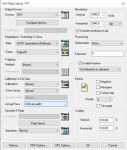gordo
Well-known member
The only difference to your recommendation is that he uses a linearization (curve 1), too, which really does not matter in this case.
You probably say "12 noon" instead of just "noon" (the 12 is redundant) ;-)
In lean manufacturing terms the 2nd most common wastes is excess processing. Excess processing is a sign of a poorly designed process. A redundant step like applying a curve to linearize plates before applying a second curve to affect tone reproduction in presswork is an example of excess processing.
You gave a good reason for why linearizing the plate is probably a carry over from the old film to plate days and that is no reason to continue doing it. So, I'm just being more adamant about removing redundancy and making the process as simple and variable free as possible.













